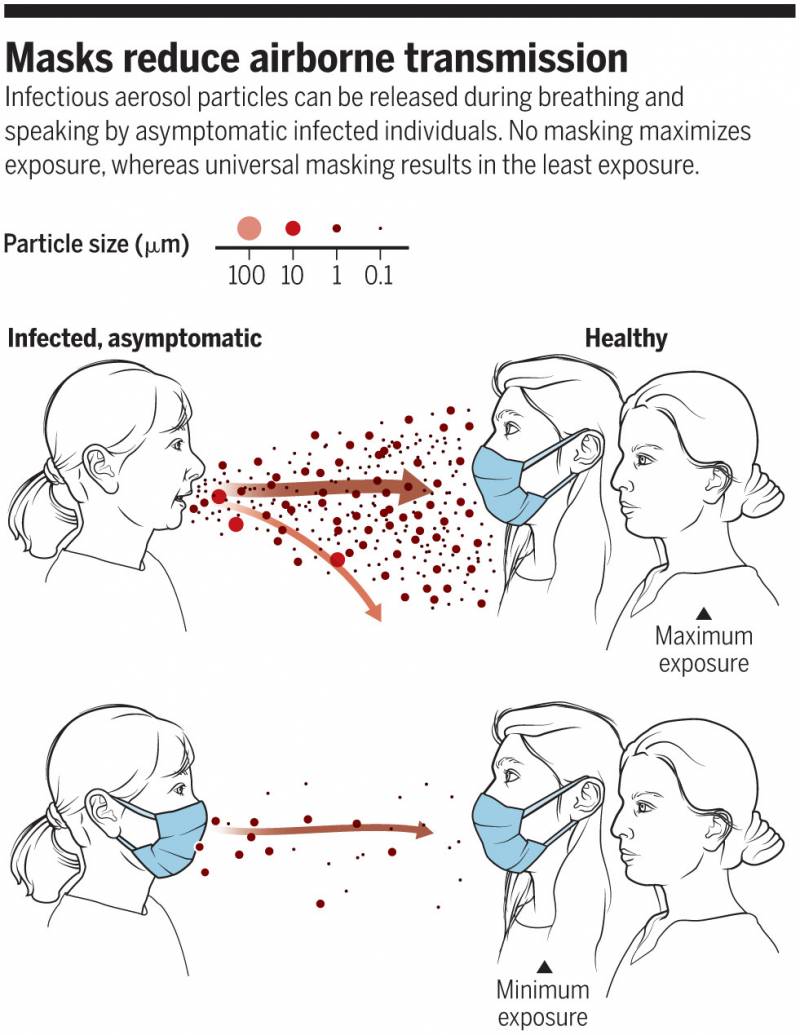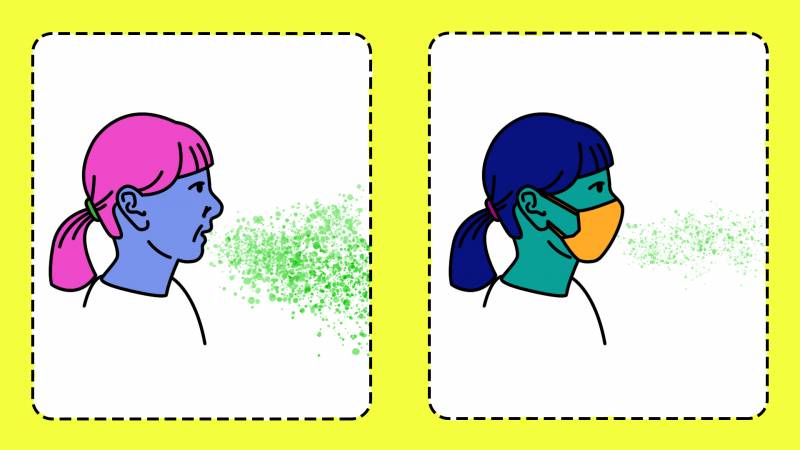Updated Oct. 27, 2020
From the beginning of the pandemic, health officials have repeated it like a mantra: Stay 6 feet apart. That guidance is now so embedded in the culture, it’s inspired a wealth of signage, graphics and even songs.
Why keep so distant? Well, the coronavirus is frequently spread through relatively large respiratory droplets emitted when people speak, cough, sneeze, sing and even breathe. Scientists believe these droplets fall to the ground within 6 feet of the person emitting them, so putting more than that amount of space between you and another person creates a buffer zone against viral transmission.
But in the last several months, scientists have taken another look at that famous 6-feet rule because of increasing evidence that the virus is airborne.
In July, more than 200 scientists signed an open letter to the World Health Organization, asking it to adopt precautions in recognition of the “significant potential” for the virus to spread via smaller respiratory particles that linger in the air. Because they can stick around and circulate, scientists call this aerosol transmission.
Shortly after that letter, the WHO issued a new scientific brief, acknowledging that transmission from much smaller particles than droplets couldn’t be ruled out and that more research is required about outbreaks in poorly ventilated indoor spaces.
The U.S. Centers for Disease Control and Prevention also arrived at this conclusion a couple of months later. In September, it referred on its website to the virus as “airborne,” but soon removed the language, claiming it was posted in error. It then published a less-definitive warning this month, stating “COVID-19 can sometimes be spread by airborne transmission.”
So what is really going on here? Let’s break it down…
What is the difference between droplets and aerosol particles?
Simply put: size.
The virus particles we send out into the world by coughing, sneezing, talking or breathing come in various proportions.
Respiratory droplets, while still very small, are sometimes big enough to be seen and felt when you’re unlucky enough to catch a sneeze in the face.
Aerosol particles, also called microdroplets, are much smaller versions of respiratory droplets: It would take 10 or more to span the width of a human hair.
Unike respiratory droplets, which quickly fall to the ground, aerosols are so small that scientists believe they can linger in the air for minutes or even hours.
Do scientists really know that aerosol transmission is happening?
Multiple scientists who study airborne transmission of infectious diseases say there is ample evidence that airborne transmission is occurring, and no evidence that it’s not.
“In my mind there is no question that aerosols are a transmission route, and possibly the most important. I cannot come up with an alternate, plausible explanation for ‘super spreader’ events,” said UC Irvine chemistry professor Ann Marie Carlton, who signed the letter to the WHO.
That is really now the main controversy about airborne transmission: Just how significant is it compared to other modes of transmission?
Both the CDC and WHO currently state the dominant path of infection is through respiratory droplets. The WHO also says surfaces play a major role.
Other scientists who study indoor air quality and aerosol science have published an open-source document called FAQs on Protecting Yourself from COVID-19 Aerosol Transmission, arguing that “the aerosol pathway is at least as important” as respiratory droplets and surfaces. “Some of us think that the aerosol pathway is the dominant way of transmission.”
In a Sept. 30 interview with Wired magazine, Dr. Anthony Fauci, director of the National Institute of Allergy and Infectious Diseases, said, “I believe pretty confidently” that some aerosol transmission was taking place. But he said just how much is unclear. “It is likely that it is not the major form of transmission,” he said. “That the major form is still that droplet type of transmission from person to person in close contact.”
OK, so what can we do to reduce our risk of catching the virus through aerosols?
A lot of what we are doing to protect ourselves from the spread of the virus through respiratory droplets will protect us from aerosols, too — measures like moving gatherings outside and wearing a mask. When everyone wears a mask, it can reduce how many droplets, of any size, escape into the environment.

Given that indoor environments with poor air circulation are a major concern for potential airborne transmission, scientists recommend that people avoid the following:
- Spaces with poor ventilation
- Spaces where you are close to others
- Places where people gather for an extended period of time
- Places where people are talking, singing, yelling or engaging in aerobic exercise
You should also:
- Wear a mask indoors
- Open windows and doors to improve ventilation
- Commercial properties or buildings should use air filters that bring in outdoor air rather than recirculating it. Buildings with a MERV 13 filter or higher will do a good job of capturing particles that carry the virus
- At home, use portable HEPA air filters, which are able to filter out particles that carry the coronavirus

